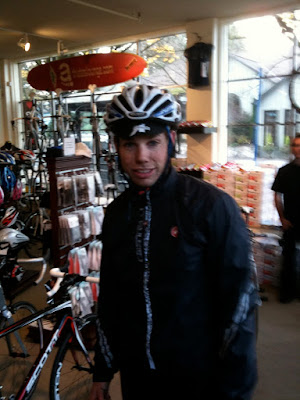
The season is over. 2009 carried some amazing highs and terrible lows in all the aspects of my existence, as every year carries: love, racing, teaching, writing, and training all conspired to reiterate that constant message: change and flux is the only constant.
I've been reading A New Earth, by Eckhart Tolle, and I won't bore you with the New Age details. Suffice it to say that, if it speaks to you, it speaks to you, and Tolle wants to tell us that looking at the world in terms of "highs" and "lows" is a dangerous way to look at the world. The goal of his book is what he would probably call "presence," and I talked a little bit about it my last post about 'Cross Nationals.
Simon Whitfield is, to me, the kind of athlete who embodies presence. People present in the moment seem to radiate calm and happiness; that is because they are not worried about the future of ensconced in the past. It strikes me as odd, though, that an endurance athlete, someone whose "successes" and "failures" are measured by the cold hands of the clock, could find himself so outside of time.
Try to remember your last best run, swim, ride, or race. If it truly was your best experience, the clock probably meant little. You floated through the workout, lending credence to the pain and pleasure of the effort in equal parts. At the end of the workout, you probably felt peace instead of relief. That sense of peace is what the best athletes in the world are looking for, I believe. I don't think they actively search for it, but it is the thing that keeps them coming back, and keeps them successful. The ego is a voracious thing, and you could say that the ego is what makes these athletes return to the starting line. But athletes motivated by ego, I believe, post uneven results, and eventually disappear from the sport or turn to illegal means of athletic success. Old friend Janda Ricci-Munn always said, when discussing dopers, "How could they be happy with their results?" I think that they are never happy, whether or not they are winning races. Think of poor, distraught Marco Pantani, or Frank Vandenbroucke, both victims of their own egos and addictions.
Athletes like Simon, though, or Greg Bennet, or Jens Voigt or Katie Compton or Barry Wicks or Chrissie Wellington all come to races and experience the race, and themselves, for who they are. The races do not foster an artificial sense of self, for them. For them, the deep discomfort of racing allows them to remain totally in the moment, and that is why they stay successful season after season.
As I walked to the coffeeshop this morning, the sun shone through the mid-December air. Wreaths and evergreens hung on doors and fences. The city felt hushed: school's out, businesses are quiet, people drive more slowly. I listened to music, remembering Emerson's words that music is one of "God's revealers." What does he mean by that, since Emerson wasn't the most traditionally religious philosophers out there? To Emerson, as to Tolle, one finds God in the moment of presence, and music gets us out of our thoughts (which are not us) and worries—we walk along, buoyed by the beauty someone else has brought into the world. I think this fact is why athletes often perform better if they listen to music while training or racing.















